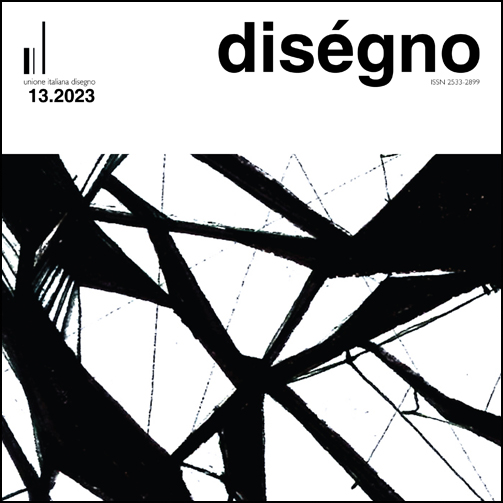Drawing and Performing Exploration in Ruin Site
DOI:
https://doi.org/10.26375/disegno.13.2023.12Parole chiave:
ruin, operation, time, aesthetic, Avant-gardeAbstract
Concept of ruin is changed today. Building mass becomes a tool for terrorization of the body, it is a structure for the community's memory, and building becomes a place where working as witness is revelatory. The representation of ruin has an important role which not only presents various unity between subject and mass but also creates non-contextualized dialog in which all subjects and their relation with the site is drawing various abstract presentations of the environment. This paper is based on the concept of ruin which comes to architectural design practice in history. The aim of this paper is to meet our ancestral colleague today’s experiment of ruin and ruining site at first find a contemporary model and perspective to evaluate this areal research. Drawing is not an analytic tool; drawing becomes a tool to progress the investigation on site what is not given by space in the moment. Drawing ruins offers special interaction with the 21st century where the world of crises becomes a chance to change the dynamic of life in terms of culture and aesthetics. As a result, what drawing ruins teaches us, as it did help with its sacred inspiration about form animation of architects, expands the form to use as a key in tying moments for developing alternatives of experiment in actual time. Drawing is a creation of an actual miracle against physical limits which is an experience kind of a censure.
Riferimenti bibliografici
Borie, A. et al. (2006). Forme et déformation des objets architecturaux et urbains. Marseille: Éditions Parenthèses.
Brook, P. (2018). Photographer Exposes Crime Scenes, With a Dash of Chemistry: <https://www.wired.com/2010/12/strassheim-crime-scenes/#slideid-161852> (accessed 4 July 2023).
Canguilhem, G. (2012). On the Normal and the Pathological (Vol. 3). Dordrecht: Springer Science & Business Media.
Farberov, S. (2014). Glowing trail of bloodshed: Photographer uses chemistry trick to uncover hidden traces of domestic violence in chilling murder scene pictures. Photographer Angela Strassheim visited 140 crime scenes while working on her portfolio ‘Evidence’: <https://www.dailymail.co.uk/news/article-2695347/Glowing-trail-bloodshed-Photographer-uses-chemistry-trick-uncover-hidden-traces-deadly-domestic-violence-chilling-black-white-pictures.html> (accessed 4 July 2023).
Foucault, M. (1995). Discipline and Punish: The Birth of the Prison. Bari: Vintage.
Ginsberg, R. (2004). The Aesthetics of Ruins. Leiden: Brill.
Isozaki, A. (2004). Incubation Process. In GA Document, Special Issue Arata Isozaki, 77, pp. 118, 119.
Koolhaas, R. (2002). Junkspace. In October, Vol. 100, pp. 175-190.
Tsybulnyk, T., Parvulesco, E. (2019 October 25). K-Object by LL Group. <https://creatingruin.net/project/k-object> (accessed 4 July 2023).
McMorrough, J. (2008). Ru(m)inations: The Haunts of Contemporary Architecture. In Perspecta, 40, pp. 164-169.
Morton, T. (2013). Hyperobjects: Philosophy and Ecology after the End of the World. Minnesota: University of Minnesota Press.
Morton, T. (2016). Dark ecology: for a logic of future coexistence. Columbia: Columbia University Press.
Muñoz-Vera, G. (2012). Ruskin and the ruins: the stain of time in architecture: <https://gonzalomunozvera.com/papers-Ruskin-and-the-ruins-the-stain-of-time-in-architecture> (accessed 14 July 2023).
Nail, T. (2017). What is an Assemblage?. In SubStance, 46(1), pp. 21-37.
Simmel, G. (1958). Two essays. In The Hudson Review, 11(3), pp. 371-385.
Strassheim, A. (2009). <http://www.angelastrassheim.com/new-page> (accessed 14 July 2023).
Wölfflin, H. (2009). Rönesans ve Barok. İtalya’daki Barok Üslubun Özüve Ortaya Çıkışı Üzerine Bir İnceleme. (Translated by tA. Tümertekin, N. Ülner). Istanbul: Janus Yayıncılık.
##submission.downloads##
Pubblicato
Come citare
Fascicolo
Sezione
Licenza
Copyright (c) 2023 diségno

TQuesto lavoro è fornito con la licenza Creative Commons Attribuzione 4.0 Internazionale.






